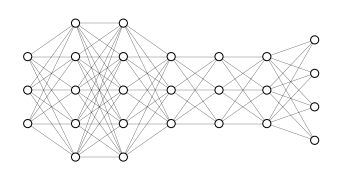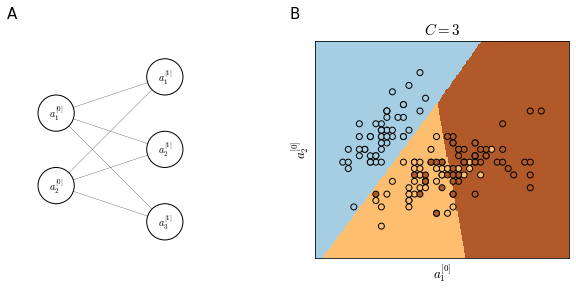Softmax regression
Softmax regression allow multi-class classification. A multi-class classifier is able to discriminate among $C$ different classes. So our neural network will have $C$ hidden units in its output layer $n^{[L]}=C$. For example in Figure 73 we have a 4 class classifier.

In general, we expect that each of the output unit will give the probability that an input belong to each class. For the neural network in Figure 73:
\[\begin{aligned} & P(0 | x)\\ & P(1 | x)\\ & P(2 | x)\\ & P(3 | x)\\ \end{aligned}\]and the output is
\[\hat{y} \in \mathbb{R}^{4 \times 1} \qquad \to \qquad \sum_{j=1}^{C} \hat{y}_j = 1\]In order to achieve that softmax regression is used in layer $L$ where the softmax activation function is applied to $z^{[L]}$
\[\begin{aligned} & z^{[L]} = w^{[L]} a^{[L-1]} + b^{[L]} \\ & a^{[L]} = \frac{t}{\sum_{j=1}^C t_j} \in \mathbb{R}^{C\times 1} \end{aligned}\]where $t=e^{\left(z^{[L]}\right)}$. Differently from other activation functions, the softmax activation takes as input a $(C, 1)$ vector and outputs a $(C, 1)$ vector instead of a single value as the activation functions that we have seen until now.
Softmax regression generalizes logistic regression
Suppose we have a very simple neural network as in panel A of Figure 74 how the learned decision boundaries (calculated by assigning each pixel in the feature space to one of the tree classes) are linear. Linearity is due to the low complexity of the neural network that has no hidden layers.

Loss function
In softmax regression the Loss function $\mathcal{L}$ that we typically use is
\[\mathcal{L}(\hat{y}, y)=-\sum_{j=1}^Cy_j \log\hat{y}_j\]suppose we have
\[y=\begin{bmatrix} 0\\1\\0\\1 \end{bmatrix} \qquad \qquad \hat{y}=\begin{bmatrix} 0.3\\0.2\\0.1\\0.4 \end{bmatrix}\]Then, since $y_1, y_3, y_4 = 0$, we have
\[\begin{split} \mathcal{L}(\hat{y}, y) & = - ( 0 + \log \hat{y}_2 + 0 + 0) \\ &= -\log \hat{y}_2 \end{split}\]Which means that if we want to minimize $\mathcal{L}$, we need $\hat{y}_2$ to be as big as possible. This is a form of maximum likelihood estimation.
The cost function $J$ is, as usual
\[J(w^{[1]}, b^{[1]}, \dots) = \frac{1}{m} \sum_{i=1}^m \mathcal{L}(\hat{y}, y)\]